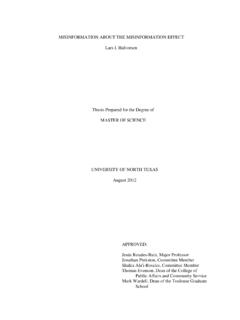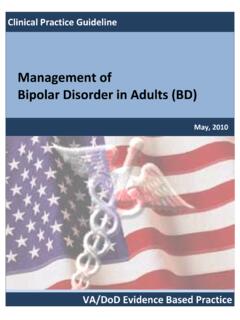Transcription of Bipolar disorder in the family: Impact on functioning and ...
1 APPROVED: Patricia Kaminski, Major Professor and Department Chair Camilo Ruggero, Committee Chair Shelley Riggs, Committee Member Amy Murrell, Committee Member Vicki Campbell, Chair of Department of Psychology James D. Meernik, Acting Dean of the Toulouse Graduate School Bipolar disorder IN THE family : Impact ON functioning AND ADJUSTMENT TO COLLEGE Erin Crandall, Thesis Prepared for the Degree of MASTER OF SCIENCE UNIVERSITY OF NORTH TEXAS August 2011 Crandall, Erin. Bipolar disorder in the family : Impact on functioning and adjustment to college. Master of Science (Counseling Psychology), August 2011, 39 pp., 3 tables, reference list, 45 titles. Bipolar disorder is a serious mental disorder , affecting anywhere from 2 to 4 percent of Americans. Though research has indicated that this disorder can be devastating for patients, less is known about how the disorder impacts family members.
2 There is no research that has considered impacts on family members adjusting to college. The purpose of the current study was to determine the extent to which having a family member with Bipolar disorder impacts adjustment to college, as well as factors that might account for worse functioning . Two groups were recruited: students with a Bipolar family member (n = 25) and students with no family history of the disorder (n = 50). Participants were interviewed regarding their own histories of a mood disorder , as well as mood disorder histories in their immediate families. They then completed surveys assessing adjustment to college, functioning , caregiving burden, parental relationship, and attachment style. Students with a family history of Bipolar disorder had significantly lower social adjustment scores, lower personal-emotional adjustment scores, and lower financial functioning scores than students without this history.
3 Lower scores were found even after controlling for psychopathology. Avoidant attachment behaviors, anxious attachment behaviors, and aspects of the paternal relationship were identified as potential mediators. Caregiving burden was identified as a partial mediator. Implications for families and educational institutions are discussed. ii Copyright 2011 by Erin Crandall iii TABLE OF CONTENTS Page LIST OF TABLES .. iv Chapters I. INTRODUCTION ..1 Definition, Prevalence, and Cost of Bipolar disorder Impact of Bipolar disorder on family Members and Caregivers Negative Effects Associated with Having a family Member with Bipolar disorder Effects on Attachment Style Associated with Having a family Member with Bipolar disorder Caregiving Burden Associated with Having a family Member with Bipolar disorder College Adjustment Summary of Literature Purpose and Hypotheses II.
4 METHODS ..14 III. RESULTS ..19 IV. DISCUSSION ..24 BIBLIOGRAPHY ..33 iv LIST OF TABLES 1. Demographics by Group ..30 2. Major Outcomes by Group ..31 3. Correlations between Zarit Burden Scores and Adjustment Outcome Variables ..32 1 CHAPTER I INTRODUCTION Bipolar disorder is a serious mental illness affecting millions of Americans. A number of studies have considered the Impact of this disorder on patients, but far fewer have considered how it affects the family members of those individuals. Moreover, no previous study has considered how it affects family members adjusting to college. The present work begins with a description of the prevalence, costs, and definition of Bipolar disorder . Existing literature on how Bipolar disorder impacts family members is reviewed, including discussion of factors that mediate whether having a family member with Bipolar disorder affects functioning .
5 Such factors may be numerous, but the present study considered the family member s own predisposition to mental illness, caregiving responsibilities, and issues related to parenting and attachment styles. The thesis concludes with the results and discussion from a survey comparing functioning in college students who have a family member with Bipolar disorder to those with no such family history. Definition, Prevalence, and Cost of Bipolar disorder Central to the defining criteria of Bipolar disorder are symptoms of either mania or hypomania (American Psychiatric Association [DSM-IV-TR], 2000). The latter are episodes of intensely elevated or euphoric mood, or they can be dominated by irritability. Patients also must report other symptoms, such as inflated self-esteem, decreased need for sleep, pressured speech, flight of ideas, distractibility, increased involvement in goal-directed activity or psychomotor agitation, and excessive involvement in pleasurable activities that have a high potential for harm.
6 Manic episodes must last a week and/or cause serious impairment, whereas hypomanic episodes require only four days and do not cause impairment. Depression is common in Bipolar disorder , 2 but as many as one quarter to one third of individuals never report such an episode (Karkowski & Kendler, 1997; Kessler, Rubinow, Holmes, Abelson, & Zhao, 1997; Weissman & Myers, 1978). According to the Diagnostic and Statistical Manual of Mental Disorders (DSM-IV-TR) there are actually four types of Bipolar disorder (2000). Bipolar I disorder is characterized by at least one past episode of mania (or mixed episode involving depressive symptoms), with or without a previous depressive episode. Bipolar II disorder , in contrast, requires a previous episode of hypomania with a previous major depressive episode. Cyclothymia involves manic and depressive symptoms that do not meet full criteria for a manic, mixed, or depressive episode.
7 Finally, Bipolar disorder not otherwise specified (NOS) is diagnosed in subthreshold cases of cyclothymia, Bipolar I or II disorder . There are high rates of recurrence associated with these disorders, and residual symptoms between major episodes are common (Judd et al., 2003). This is true even for those receiving treatment (Angst & Sellaro, 2000). Traditional estimates suggest Bipolar disorders affect about million Americans in any given year, or about of the US population (National Institute of Mental Health, 2010). A recent large-scale epidemiological survey, the National Comorbidity Survey Replication (Kessler et al., 2005) reported a percent lifetime prevalence of Bipolar I and II disorders. Other studies, however, have found prevalence rates as high as 8% (Angst, 1998). Bipolar disorders are associated with significant costs.
8 Research has shown that this group of disorders results in significantly higher costs to society than most other psychiatric disorders (Bryant-Comstock, Stender, & Devercelli, 2002; Kent, Fogarty, & Yellowlees, 1995). These disorders have been found to create significant economic burden, and the annual cost of 3 these disorders is estimated to range from $10 billion to just under $50 billion ( , Begley et al., 2001; Wyatt & Henter, 1995). The disorders also result in significant personal costs. Bipolar disorders are associated with increased risk of suicide (Isometsa, Henriksson, Aro, & Lonnqvist, 1994; Angst, Staussen, Clayton, & Angst, 2002) as well as impairment in social functioning (Coryell et al., 1993; Dion, Tohen, Anthony, & Waternaux, 1988; Ruggero, Zimmerman, Chelminski, & Young, 2006). In sum, the disorders have significant costs, not just for the people afflicted, but for society as a whole.
9 Impact of Bipolar disorder on family Members and Caregivers While much is known about the Impact of Bipolar disorder on those afflicted with the condition, far less is known about the Impact of the disorder on non-affected family members. A few studies have suggested that having a first degree relative with Bipolar disorder may be associated with positive outcomes. Bipolar disorder has been associated with higher levels of achievement (Johnson & Carver, 2006) and first degree relatives may have positive outcomes with regard to achievement and occupational status (Coryell et al., 1989; Bagley, Jacobson, & Palmer, 1973; Woodruff et al., 1971). Other studies suggest that first degree relatives of individuals with Bipolar disorder show significantly higher levels of creativity (Richards et al., 1988; Simeonova et al.)
10 , 2005). It is unknown whether this link to creativity was due to genetic or environmental factors, although some studies suggest a genetic component to this interaction (McNeil, 1971). Despite the possible positive outcomes in relatives of patients with Bipolar disorder , a greater number of studies show that families of Bipolar disorder experience serious negative outcomes. Existing literature has considered negative impacts among the offspring of parents 4 with Bipolar disorder , including increased risk of psychopathology as well as attachment style and parenting. A separate literature has explored the Impact on caregivers, who are often family members. Each of these lines of evidence is reviewed. Negative Effects Associated with Having a family Member with Bipolar disorder Research has supported the idea that family members of individuals with Bipolar disorder are at greater risk for developing several mental disorders as well as other developmental problems.



















